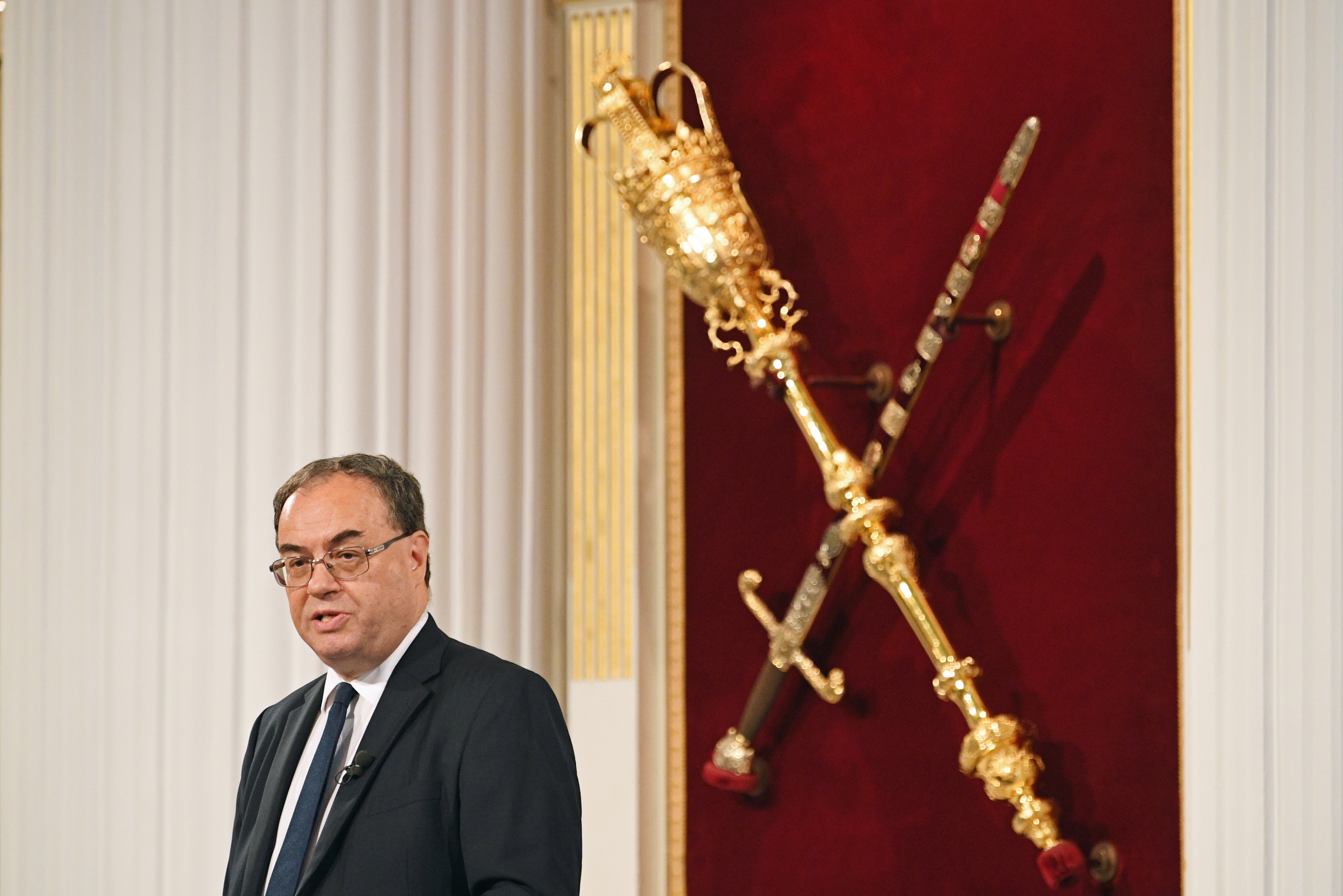The Bank of England’s inflation problem is getting awkward
The central bank is in an increasingly tight spot, penned in by rising prices and weakening growth, writes Anna Isaac


Your support helps us to tell the story
From reproductive rights to climate change to Big Tech, The Independent is on the ground when the story is developing. Whether it's investigating the financials of Elon Musk's pro-Trump PAC or producing our latest documentary, 'The A Word', which shines a light on the American women fighting for reproductive rights, we know how important it is to parse out the facts from the messaging.
At such a critical moment in US history, we need reporters on the ground. Your donation allows us to keep sending journalists to speak to both sides of the story.
The Independent is trusted by Americans across the entire political spectrum. And unlike many other quality news outlets, we choose not to lock Americans out of our reporting and analysis with paywalls. We believe quality journalism should be available to everyone, paid for by those who can afford it.
Your support makes all the difference.Inflation is becoming increasingly hard to ignore.
From central bankers to ordinary consumers grimacing at their energy bills, the pace at which prices are rising has become a pressing concern. Investors are worried too.
Financial markets are betting that the key Bank of England interest rate could rise to 1 per cent by the end of 2022, the highest rate in more than a decade, starting with a small 0.15 percentage point rise this coming December. But this is set against an uncertain global economic outlook, and a UK recovery which seems to be losing steam, limited by shortages in materials and labour.
That puts the Bank of England in a tight spot. On 4 November Threadneedle Street’s interest rate setters must confront a problem they have been weighing for months – whether climbing inflation is a short-term pandemic pest, arising from turning the economy off and back on again as well as scrambling global supply chains, or a persistent problem that must be contained with an interest rate hike.
If the committee of rate setters do increase the key interest rate, it would mean the central bank has to move ahead of its international peers, hiking ahead of the US Federal Reserve, and the European Central Bank.
The Bank of England’s own forecast is that inflation will reach more than 4 per cent by the end of this year, potentially overtaking the underlying growth in real average wages calculated by the Office for National Statistics. US figures, out Wednesday, showed price growth in the world’s largest economy remains elevated.
Andrew Bailey, governor of the Bank of England, has shifted his tone on the issue. In July, he said it was “important not over-react to temporarily strong growth and inflation”. Last week he said: “We have got some very big and unwanted price changes” which could prove “very damaging” if they become “embedded” in the economy, longer term.
Interest rate rises are painful for an individual who might have a mortgage or debts, but they can be good news for savers, and they move vast waves of money around in financial markets.
But while investors’ bets indicate that a hike will come soon, before the end of the year, some economists think this would be a misstep. It’s been hard to work out exactly what the central bank is leaning towards.
Investors are obsessed with examining every word those central bankers say, be it written or spoken. Many now use artificial intelligence to try and build up tracts of linguistic habits to work out, what, exactly, a given phrase might indicate. The Bank of England, like other central banks, knows this, and therefore tries to offer calm, clear signals to markets, to avoid panic or disruption.
Still, this sensitive chain of communication got a bit muddled around paragraph 65 in the latest Bank of England minutes, according to John Wraith, head of rates strategy at Swiss bank UBS.
It read: “All members in this group agreed that any future initial tightening of monetary policy should be implemented by an increase in Bank Rate, even if that tightening became appropriate before the end of the existing UK government bond asset purchase programme.”
The bond buying effort referred to, also termed quantitative easing (QE), is due run up to mid-December. Investors inferred that this was therefore a signal for a rate rise as soon as November, based on paragraph 65. But Wraith does not think it is quite that simple.
“My interpretation is they’re not saying ‘hint hint, we think we might raise rates any minute now,’” Mr Wraith says. Rather, it was a signal that if rate setters worry that inflation is getting out of hand, they will raise interest rates first. It is not a deadline, Wraith explains.
It’s a view shared by Neil Shearing, group chief economist at Capital Economics. He does not think a hike this year is a “done deal”, but that it’s likely the key rate will rise before May 2022.
Still, analysts at Goldman Sachs said on Friday that a hike at the November meeting was “more likely” than in December, and that, in their view, rates would rise this year.
Several forces are feeding inflation in the UK now, with many of them external as well as domestic. The UK is an import-dependent country, from serving its energy and food needs, to its reliance on foreign investment to fund its current account deficit. And while global prices for a host of commodities have risen, the value of the pound has weakened. This has led to more imported inflation.
But if the Bank of England tries to clamp down on that price pressure too soon, it could backfire.
“I think that raising the rate now would be partly in the hope, or the aim, of strengthening sterling,” Mr Wraith says. But that could be a bad signal to send to investors when other evidence suggests the economic recovery is still fragile. “The danger is that the market says ‘well, you’ve gone too early here’.”
While expectations of high interest rates normally increase a currency’s value, recent expectations for a rate increase have had the opposite effect. Data from the Commodity Futures Trading Commission showing bets against the pound indicates that currency traders think a hike would backfire, as Mr Wraith suggests. Rather than strengthening sterling, in their view high interest rates could weaken it further, by slowing down economic growth.
There are also labour mismatches in the economy to contend with. Furlough has ended and record high vacancies have been advertised, but some workers appear to be falling out of the labour market altogether, while other, freed-up workers do not necessarily fit with the skills employers need.
This mismatch effect means that while the picture of the labour market can seem positive it is not what economists term as “tight”. This means what seems to be a traditional source of inflation – high employment, which can drive up wages as demand from employers meets the limit of supply of workers – might just be an effect in some sectors, rather than economy-wide.
A cost-of-living crisis is also looming, in which many benefit claimants have jobs, but are under-employed and with too few hours, or too low-paid to meet their needs.
“The economy has been bent out of shape by the pandemic,” says Ian Mulheirn, chief economist at the Tony Blair Institute for Global Change. “At the moment you still have to take the view that the inflationary effect is temporary.”
But being temporary doesn’t mean price growth will ease quickly. “One thing that’s more sobering is that these pressures could go on for a while,” Mr Mulheirn explains. Inflation could stay high, well above the central bank target of 2 per cent, into next year.
That’s partly why, in his view, governor Bailey is starting to talk tough on price pressures in order to try and manage expectations as inflation proves stickier than first hoped.
“There’s a premium on looking vigilant at the moment. Perhaps the hope is that by looking vigilant you don’t have to act quite as quickly as if you sound relaxed. I suspect that they’re trying to send a message,” Mr Mulheirn says. But the costs of “acting too soon” and bowing to pressure to hike rates are greater than the “much less significant” risk of inaction at the present moment.
Some around the table who will make a decision about interest rates in a few weeks believe that a hike this year would be too severe for the economy to take. But there’s no question that inflation has proved more persistent than first forecast, nor is there any doubt among economists that the UK has a long way to go in its post-pandemic recovery.
“As the governor himself said, there are ‘hard yards’ ahead. That seems undeniable to me,” says Mr Wraith.


Join our commenting forum
Join thought-provoking conversations, follow other Independent readers and see their replies
Comments